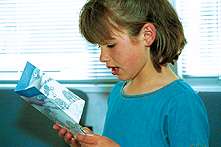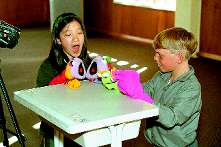| ACKNOWLEDGEMENTS |
The Project directors acknowledge the vital support and contributions of many people to this report, including:
• the very dedicated staff of the Educational Assessment Research Unit
• Dr Hans Wagemaker and Mr James Irving, Ministry of Education
• members of the Project's National Advisory Committee
• members of the Project's Reading and Speaking Advisory Panel
• reading consultants, Professor Warwick Elley and Ray Griffiths, who assisted greatly with task production
• principals, staff, and children of the schools where tasks were trialed
• principals, staff, and Board of Trustee members of the 265 schools included in the 1996 sample
• the 2868 children in the 1996 sample, and their parents
• the 95 teachers who administered the assessments to the children
• the 22 senior tertiary students who assisted with the marking process
• the 150 teachers who assisted with the marking of tasks early in 1997
New Zealand's
National Education Monitoring Project commenced
in 1993, with the task of assessing and reporting on the achievement
of New Zealand primary school children in all areas of the school
curriculum. Children are assessed at two class levels: Year 4 (halfway
through primary education) and Year 8 (at the end of primary education).
Different curriculum areas and skills are assessed each year, over
a four year cycle. The main goal of national monitoring is to provide
detailed information about what children can do so that patterns
of performance can be recognised, successes celebrated, and desirable
changes to educational practices and resources identified and implemented.
 Each
year, small random samples of children are selected nationally, then
assessed in their own schools by teachers specially seconded and trained
for this work. Task instructions are given orally by teachers, through
video presentations, or in writing. Many tasks involve the children
in the use of equipment and supplies. Their responses are presented
orally, by demonstration, in writing, or through submission of other
physical products. Many of the responses are recorded on videotape
for subsequent analysis.
Each
year, small random samples of children are selected nationally, then
assessed in their own schools by teachers specially seconded and trained
for this work. Task instructions are given orally by teachers, through
video presentations, or in writing. Many tasks involve the children
in the use of equipment and supplies. Their responses are presented
orally, by demonstration, in writing, or through submission of other
physical products. Many of the responses are recorded on videotape
for subsequent analysis.
In 1996, the second year of national monitoring, four areas were assessed: music, reading, speaking, and aspects of technology. This report presents details and results of the assessments in reading and speaking.
The assessments revealed wide variations in performance on reading tasks. Overall, a high percentage of year 8 students and a moderate percentage of year 4 students demonstrated good technical skills when orally reading text. Approximately 80 percent were at or above the levels we regarded as normal for their year at school. However, about 10 percent lagged well below these levels, performing at least three years below the normal levels. Year 8 students performed substantially better than year 4 students on tasks involving reading comprehension, but few students were able to give full answers to questions that required them to construct and write their own answers rather than select from multiple choice options. Many students were also challenged when required to adjust their reading technique to suit a particular purpose, such as skimming quickly to find key information.
 On
speaking tasks, year 8 students performed better than year 4 students
on task aspects which required organising ideas and information effectively,
or giving clear explanations. Year 4 students often performed as well
as year 8 students on aspects which involved dramatisation or creative
expression. This may be because year 4 students are more spontaneous
and less inhibited by peer expectations.
On
speaking tasks, year 8 students performed better than year 4 students
on task aspects which required organising ideas and information effectively,
or giving clear explanations. Year 4 students often performed as well
as year 8 students on aspects which involved dramatisation or creative
expression. This may be because year 4 students are more spontaneous
and less inhibited by peer expectations.
Among 12 school subjects, reading was in the middle in popularity for students at both levels, while speaking was low in popularity. Year 4 students had a more technical view of reading, emphasising trying hard and learning hard words, while year 8 students emphasised enjoyment. Students at both levels enjoyed reading fiction, but year 8 students enjoyed magazines more and comics and poetry less than year 4 students. On a list of nine "spare time" activities, reading was the least popular activity at both year levels. Speaking to the whole class was an unpopular activity for many students, particularly year 8 students.
Girls at both year levels
performed better than boys on most reading tasks, and also gave more
positive ratings on several questions of the reading survey. Non-Mäori
students performed better than Mäori students on all ten reading
tasks at year 4 level and on six of ten reading tasks at year 8 level,
but both groups gave similar survey ratings. Given the importance of
reading in other aspects of the school curriculum and in community
life, these patterns must be of concern. They were more extreme for
reading than for any other area assessed in the 1995 or 1996 assessments.